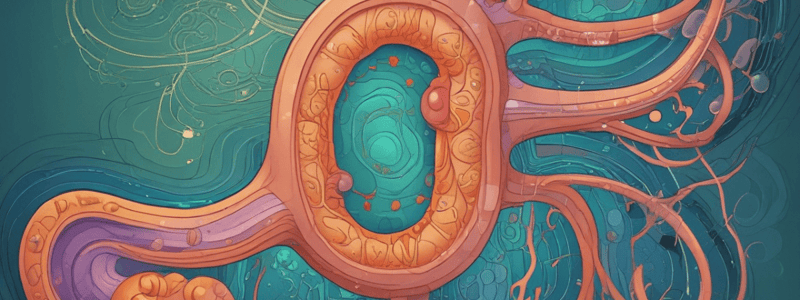Podcast
Questions and Answers
What is the primary finding of Friedrichs and Schoner's study on rat renal tubules?
What is the primary finding of Friedrichs and Schoner's study on rat renal tubules?
- Glycolysis is the primary source of ATP for sodium transport in the proximal convoluted tubule
- Sodium transport and gluconeogenesis do not compete for ATP in the proximal convoluted tubule
- Sodium transport and gluconeogenesis compete for ATP in the proximal convoluted tubule (correct)
- Oxidative phosphorylation is not required for sodium transport in the proximal convoluted tubule
What is the effect of antimycin A on Na+ reabsorption and HCO3- secretion in the CCD?
What is the effect of antimycin A on Na+ reabsorption and HCO3- secretion in the CCD?
- It increases both Na+ reabsorption and HCO3- secretion
- It inhibits both Na+ reabsorption and HCO3- secretion (correct)
- It inhibits Na+ reabsorption but has no effect on HCO3- secretion
- It has no effect on either Na+ reabsorption or HCO3- secretion
What is the primary source of ATP for HCO3- secretion in the CCD?
What is the primary source of ATP for HCO3- secretion in the CCD?
- Glycolysis
- Hexose-monophosphate shunt pathways
- Oxidative phosphorylation (correct)
- Endogenous substrates
What is the characteristic of medullary collecting ducts (MCDs) compared to CCDs?
What is the characteristic of medullary collecting ducts (MCDs) compared to CCDs?
What is the effect of inhibition of glycolysis on K+ transport in the IMCD?
What is the effect of inhibition of glycolysis on K+ transport in the IMCD?
Flashcards are hidden until you start studying
Study Notes
Proximal Tubule
- Sodium transport and gluconeogenesis compete for ATP in the proximal convoluted tubule.
- Inhibition of Na+-K+-ATPase increases renal gluconeogenesis by 10-40% depending on the substrate.
- Stimulation of Na+-K+-ATPase activity with high extracellular K+ inhibits gluconeogenesis.
- Inhibition of the sodium pump induces a higher energy state of the cell, favoring energy-requiring synthetic processes.
- Increased perfusion rates decrease glucose production rate by 50%, whereas inhibition of apical transport increases glucose production rate.
- SGLT2 inhibitors reduce proximal gluconeogenesis by inhibiting SGLT2-mediated glucose uptake in diabetic mice.
- Mathematical models predict that TNa/Qo2 is 80% higher in the S3 segment of the proximal tubule due to the larger paracellular contribution to TNa.
- Inhibiting NHE3 or Na,K-ATPase reduces TNa, Qo2, and transport efficiency.
Thick Ascending Limb
- The TAL has a high rate of Na+ transport against a steep concentration gradient, high levels of Na+-K+-ATPase activity and expression, and 40% of its cytosolic volume occupied by mitochondria.
- The TAL requires oxidative metabolism to maintain cellular ATP levels and active Na+ reabsorption.
- During osmotic diuresis, medullary lactate doubles, suggesting increased glycolysis.
- Lactate production is increased in the distal segments, particularly in the TAL, during antimycin A incubation.
Cortical Collecting Duct
- CCD metabolism is characterized by the coexistence of different cell types: principal cells that reabsorb sodium and intercalated cells that secrete bicarbonate.
- Na+ reabsorption and HCO3- secretion in the CCD are dependent on oxidative phosphorylation but not on glycolysis or the hexose-monophosphate shunt pathways.
- Na+ reabsorption is best supported by a mixture of basolateral glucose and acetate, whereas HCO3- secretion is fully supported by either glucose or acetate.
Medullary Collecting Duct
- The outer medullary collecting duct (OMCD) has low sodium transport and few mitochondria.
- Bicarbonate secretion in the OMCD can be fully supported by endogenous substrates.
- The inner medullary collecting duct (IMCD) can maintain cellular ATP and respire normally in the absence of exogenous substrate.
- IMCD has a higher reliance on anaerobic metabolism but still takes advantage of oxidative metabolism to fully support transport.
- Both glycolysis and oxidative phosphorylation are required to maintain optimal Na+-K+-ATPase activity and preserve cellular K+ gradients in the IMCD.
Studying That Suits You
Use AI to generate personalized quizzes and flashcards to suit your learning preferences.




